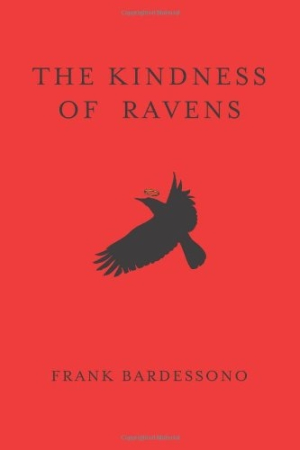The Kindness of Ravens
The profound meets the profane in The Kindness of Ravens, a story about a Generation X teenager who grows up California-style. Bardessono expertly captures the hedonism of the 1980s within the context of a spiritual quest by a trio of risk-seeking buddies who defy society’s rules in search of self-definition. Their precocious leader, Daren, however, seeks not just personal meaning but also spiritual transformation.
Opportunities for transformation abound as Daren, along with friends Alex and Keith, push the boundaries of legal, ethical, and sane behavior on their roller-coaster ride through the excesses of California Coast culture. Undoubtedly giving a nod to classics like Bright Lights, Big City, Bardessono fuels the adventures with a constant stream of drugs taken in sexually charged clubs. For some characters, these trips outside the mainstream lead to the tragedy of taking one risk too many. For others, experimentation is a step on the path toward enlightenment. Readers will see the risks coming and hope that the flawed heroes will learn their lessons before they implode.
Bardessono’s facility with language allows him to create multifaceted characters, particularly his narrator, Daren. Wryly observant, Daren is equally comfortable with the sacred and the scatological. One minute he is “the innocent schoolboy always drowned out by the disharmony of the cast of thousands,” and then he is sharing a joke about the sex lives of Scooby Doo characters. Bardessono’s dialogue nails guy talk as the young men trade quick, crass barbs that only underscore the mutual affection they seldom articulate.
The authenticity of characters like Daren keeps the magical aspects of the story from becoming outlandish. Daren, for instance, believes his first true love, Lee, is a Native American shaman, a raven in disguise. If readers didn’t know him so intimately, they might just assume he has ingested one psychedelic mushroom too many. But his inner thoughts reveal the way he considers things from all sides, so readers are more willing to open their minds to the possibilities.
The nonstop consumption of one drug after another gets repetitive as the boys fall further into addiction. Euphoric recall reigns in scenes that detail every line of cocaine with an unsettling reverence even as the dire consequences have become painfully clear to all but the addicts. The frustration Bardessono elicits will be far too familiar to friends and families of addicts. Readers will want to shake some sense into Daren at times, but they will also recognize his attempt to find meaning in the inevitable post-adolescent growing pains.
Bardessono’s attempts to wrap up the story with Daren’s mythical explanations—ravens are bearers of bad tidings, but also bringers of light—are weak in comparison to the realistic way he portrays his protagonist’s life. In the end, it is Daren’s human relationships that matter most.
Reviewed by
Sheila M. Trask
Disclosure: This article is not an endorsement, but a review. The publisher of this book provided free copies of the book and paid a small fee to have their book reviewed by a professional reviewer. Foreword Reviews and Clarion Reviews make no guarantee that the publisher will receive a positive review. Foreword Magazine, Inc. is disclosing this in accordance with the Federal Trade Commission’s 16 CFR, Part 255.

